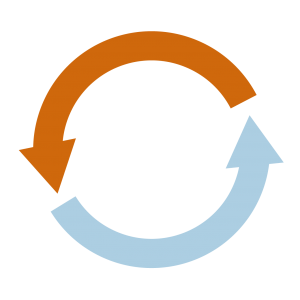So far in our series on inbound marketing, we have discussed why it matters, what tools are involved, and began looking at HubSpot’s inbound marketing methodology. At this point, you might be wondering, “How does a visitor to my website eventually become a guest at my inn?” Well, in my previous post, I explained that the first thing you need to do is attract visitors to your website. From there, the objective is simple: establish contact. When you establish a method for contacting a visitor, he/she becomes a lead.
 So how do you go about turning your visitor into a lead?
So how do you go about turning your visitor into a lead?
Convert Through Action
You can’t have something for nothing. If you want your visitors to leave contact information, offer them something in return. This is a first step in building trust and can be the beginning of a good relationship. Remember that you’re not necessarily trying to get them to just book a room right away (don’t get me wrong, it’s lovely when a visitor does). But in the big picture of your business, that’s the not the point. The point is to give visitors a reason to return to your site to explore it further, and also to reveal why your site might be useful or relevant.
A visitor rarely comes to a website randomly. There is almost always a cause. Maybe it was a blog post. Maybe it was a photo gallery. Maybe a social media post was shared and they wanted to see what your business was about. Perhaps it was part of Cost-Per-Click (CPC) advertising, such as Google AdWords or Bing Ads, or even a referral visit from a link on another website. Whatever the case, something drew that visitor to your site. It’s hard to tell at this point what exactly drew the visitor, but it’s not hard to find out if you offer a chance to connect through your site. For instance, offer a subscription to your blog via RSS feed. Or, perhaps, offer a newsletter subscription, which is an excellent way to gain contact information as a call-to-action.
A Call-To-Action (CTA) is simply a statement on your website that asks or invites the user to take a specific action. For instance, a good CTA might be “Get Our Latest Newsletter” or “Subscribe To Our Blog.” Or, perhaps, “Download Our Recipe Book.”  Clear and appropriately placed CTAs transform a mundane website into an engaging user experience. Without CTAs, a website is as good as a pond with no water flowing through it. Eventually, it stagnates into uselessness.
Clear and appropriately placed CTAs transform a mundane website into an engaging user experience. Without CTAs, a website is as good as a pond with no water flowing through it. Eventually, it stagnates into uselessness.
What happens when a visitor clicks a CTA? They are taken either to the downloadable file you’re offering or to a landing page.
Convert Through Exchange
A landing page is a solid method for obtaining an email address for follow-up communication and to begin to establish a relationship with the visitor, thereby transitioning him/her into a lead. A landing page typically contains your logo, a contact form, and a download button for whatever you’re offering. But the idea isn’t to gain a list of email addresses to spam. Instead, the idea is to have a method to contact individuals and offer more useful pieces of information. For instance, suppose you are an innkeeper and one of your biggest guest draws is your menu. People who are drawn to the food at your inn are also probably interested in all things food. Compiling recipes and making them available as a downloadable e-book is just one example of something to offer. Follow-up with the individual by offering, for instance, seasonal recipe e-books, etc. Think creatively about how to approach the individuals you draw to your website and how to establish contact with them.
Feel free to contact us for help setting up CTAs and landing pages.
Convert Through Your Contact Book
Having a many email contacts is an awesome thing. But managing them can be very troublesome and, honestly, quite time-consuming. Here is the great conflict: knowing how to reach those contacts and managing them in logical groups must be done. So, to have successful conversion into a lead, you must either devote the time to segmenting those contacts into logical groups or paying someone to do it for you.
Why does this have to be done?
It’s important to segment the contacts that you gain through your CTAs because interests vary. Therefore, what one individual might find interesting, another might not. Knowing the difference helps you tailor how to follow-up with each of them.
 For example, let’s say you gain 20 contacts from your CTAs. These 20 contacts all chose to download something or subscribe to something different. But among the 20, there were individuals who seemed to be interested in common subjects, such as wine, food, hiking, fishing, or history. But suppose you didn’t care to segment them. So you end up sending emails to all 20 individuals about a wine tasting even when only a handful were interested. Those who weren’t interested in wine would be more likely to mark your incoming messages as spam and begin to ignore you completely because you were no longer inviting them into information of interest.
For example, let’s say you gain 20 contacts from your CTAs. These 20 contacts all chose to download something or subscribe to something different. But among the 20, there were individuals who seemed to be interested in common subjects, such as wine, food, hiking, fishing, or history. But suppose you didn’t care to segment them. So you end up sending emails to all 20 individuals about a wine tasting even when only a handful were interested. Those who weren’t interested in wine would be more likely to mark your incoming messages as spam and begin to ignore you completely because you were no longer inviting them into information of interest.
There are many tools available for segmenting contacts or for managing contacts. One such tool is Highrise. In it, you can fill out business-card like contact information for your contacts and tag them in categories that can then be used to filter groups of contacts. Such tools are excellent investments if you have several contacts you want to segment.
If you’ve gone to the trouble of gaining your site visitors’ contact information, be sure that as you seek to convert them into leads that you’re continuing to attract them with useful resources and relevant information. Remember that the difference between inbound marketing and outbound marketing is that you’re invested in caring about the buyer, not in simply selling to the buyer.
Convert with Care
Think about it. Conversion is simply turning something from one state into another. Remember that conversion is not the same as closing a sale (we’ll get to that in the next post).
For our purposes, conversion is connection. Because inbound marketing is meant to be permissive, there is no other viable method by which you can go on to make a customer out of a lead. Further, there would also be no way to delight a customer. Connection
Consider the following when converting a visitor to a lead:
- Be willing to give more than you get: This sounds strange and possibly insane. However, it is a strong approach for gaining not only a customer, but also an advocate.
- Be creative: Take time to think about what to offer those who visit your site. Who is it that you’re trying to convert into a lead? Who is your ideal or target buyer? Look at your competitors’ websites and see what they’re offering in the way of CTAs.
- Be real: A surefire method for losing website visitors is by manufacturing utterly useless junk for downloads. Don’t inundate your site with flimsy CTAs that are simply meant to get contact information. Visitors will be able to detect the difference. Make the content you provide useful, relevant, and entertaining.
To Convert Is to Connect
HubSpot’s inbound marketing methodology calls this phase “Convert.” While that’s good, for our own terminology we’re going to adopt the term “Connect”. That’s what this phase is all about: connection. When you have attracted, or invited, someone to your website, communicating and connecting with them is the first step toward forming a solid relationship. Imagine if you invited guests to take a look at your inn before they decided to lodge there. But once they arrived, you never spoke to them, never got to know them, never made them feel you cared on any level. I expect that in a short time you’d find yourself out of business.
I said it before, “Inbound marketing’s total methodology is meant to be buyer-focused. Caring about what motivates, interests, and inspires your ideal buyer is a good key to attracting them to what you offer to help solve their problem or reduce their pain point.”
Ultimately, the goal of the “Convert”, or as we’ll call it, the “Connect” phase of the inbound marketing methodology is simply this: to prove that you care enough to engage. Join us for the next post in this series, “Close with Inbound Marketing”. If you’d like social media alerts of when we publish the next post, join us on Facebook, Twitter, Google+, Pinterest, and LinkedIn. Or, if you have an RSS reader, click to subscribe to our blog.
Currently, InsideOut Solutions offers blogging and email marketing services to help you improve your inbound efforts. Click below to contact us and find out more about these services.
